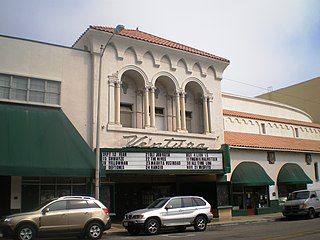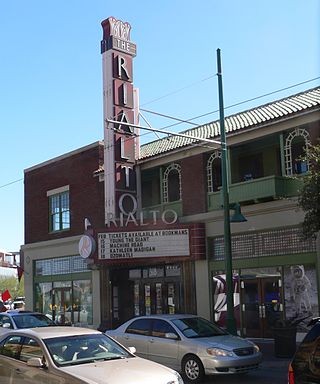
The Rialto Theatre is a performance theater and concert venue located on Congress Street in downtown Tucson, Pima County, southern Arizona. The cinema−theater and surrounding Rialto Building commercial block were listed on the National Register of Historic Places in 2003.
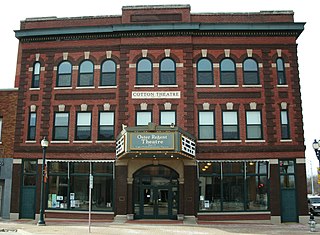
The Cotton Theatre, also known as Regent Theatre and Oster Regent Theatre, is a theater located at the corner of 1st Street and Main Street in downtown Cedar Falls, Iowa, United States. It was named for local Cedar Falls resident Frank Cotton who built the theater in 1909 and 1910.

The Playmakers Theatre, originally Smith Hall, is a historic academic building on the campus of the University of North Carolina at Chapel Hill. Built in 1850, it was designated a National Historic Landmark for its architecture, as an important example of Greek Revival architecture by Alexander Jackson Davis. It is now a secondary venue of the performing company, which is principally located at the Paul Green Theatre in the Joan H. Gillings Center for Dramatic Art.

The Schubert Theatre is a theater located in Gooding, Idaho, United States. Built in 1920, it was listed on the National Register of Historic Places in 2004.

The Fort Peck Theatre was built as a temporary structure in 1934 in Fort Peck, Montana to serve as a movie theatre. It is also known as the Fort Peck Summer Theatre. The theater was designed in a pseudo-Swiss-chalet style as an amenity for the 50,000 U.S. Army Corps of Engineers workers and their families at the Fort Peck Dam project. The interior features open-truss wood construction, with handcrafted light fixtures fabricated in Corps of Engineers workshops. The theater survived to become a permanent facility, and in 2008 was in use as a community theater.
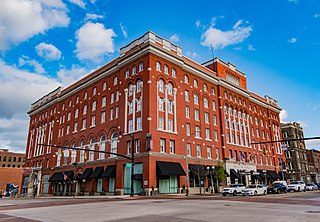
The Great Southern Hotel & Theatre is an historic hotel and theater building in Downtown Columbus, Ohio. The building currently operates as the Westin Great Southern Columbus and the Southern Theatre.
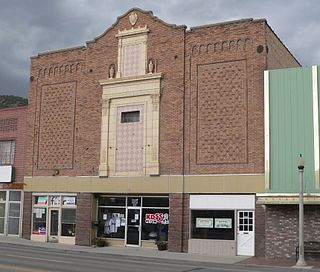
The Capital Theater in Ely, Nevada was built in 1916 by C.O. Fleming and W.P. Hull. The building began as a vaudeville hall that hosted a diverse range of live entertainment, including acrobats, comedians, lecturers, and magicians. The building reopened as a cinema in 1923, at a time when films were becoming popular. The theater closed in 1963. The building's style represents a possible reconstruction after a 1929 fire, and might best be described as Spanish Colonial Revival. The theater's design was carried out by the owners.

The Rivoli Theater is a historic theater on the eastern side of Indianapolis, Indiana, United States. The theater was built in 1927 and was designed by architect Henry Ziegler Dietz. Originally designed and built as a single screen movie theater by Universal Pictures, it was sold in 1937 and continued to provide motion pictures and live entertainment until its final closure in 1992. Since this time the venue has remained largely vacant. In 2007 the Rivoli Theater was acquired by the Rivoli Center for the Performing Arts, Inc., with the intent to restore and reopen the theater.

The F. M. Kirby Center is a historic Art Deco-Moderne style movie theater located at Wilkes-Barre, Pennsylvania. It was added to the National Register of Historic Places in 1980.
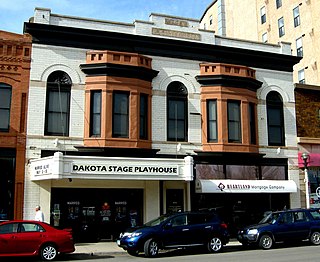
The E. G. Patterson Building at 412–414 Main St. in Bismarck, North Dakota, United States, was built in 1905. It was listed on the National Register of Historic Places in 1982.

The Strand Theatre on Hill Avenue in Grafton, North Dakota, United States, was built in 1946. It reflects Moderne architecture. It has also been known as the New Strand, as the Strand Twin Theatre, as the Deluxe Theatre, and as the Strand Deluxe Theater. It was listed on the National Register of Historic Places (NRHP) in 2004. According to its NRHP nomination form, the theater is known for a "tradition of community service" and "implementation of innovative entertainment and marketing ideas," including regular showings of foreign films.

The Coleman Theatre is a historic performance venue and movie house located on historic U.S. Route 66 in Miami, Oklahoma. Built in 1929 for George Coleman, a local mining magnate, it has a distinctive Spanish Colonial Revival exterior, and an elaborate Louis XV interior. It was billed as the most elaborate theater between Dallas and Kansas City at the time of its opening, and played host to vaudeville acts, musical groups, and movies.

This is a list of the National Register of Historic Places listings in Comanche County, Texas.
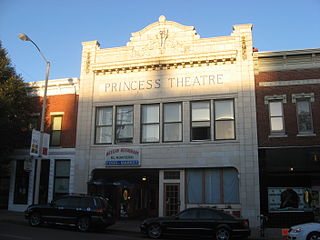
Princess Theatre, also known as the Princess Theatre Building, is a historic theatre building located at Bloomington, Monroe County, Indiana. It was built in 1892, and converted and enlarged for use as a theater in 1913. It was subsequently refurbished to its present appearance in 1923. It is a two-story, rectangular, brick building with a glazed terra cotta front. The front facade features full-height pilasters and an arched opening with decorative brackets. The theater portion of the building was removed in 1985.
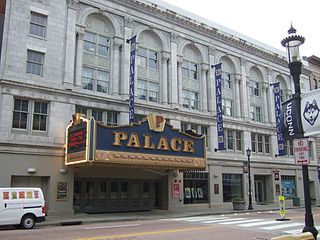
The Palace Theater is a 2,900-seat auditorium at 100 East Main Street in downtown Waterbury, Connecticut. The theater currently presents a variety of live entertainment, hosting traveling productions and locally produced events. It was built in 1921 to a Renaissance Revival design by Thomas W. Lamb, and is an architecturally prominent element of the city's downtown. It underwent a major restoration in the early 21st century, and is listed on the National Register of Historic Places.

The Chief Theater in Gallup, New Mexico is an Art Deco-style theatre built in 1920. It was listed on the National Register of Historic Places in 1988. It was then occupied by the City Electric Shoe Shop.

Fox California Theater, renamed the Bob Hope Theatre in 2004, is a commercial building in Stockton, California built in 1930. It was added to the National Register of Historic Places in 1979.

The Plaza Theater in Burlington, Kansas, at 404 Neosho St., was built in 1942. It was listed on the National Register of Historic Places in 2005.
















